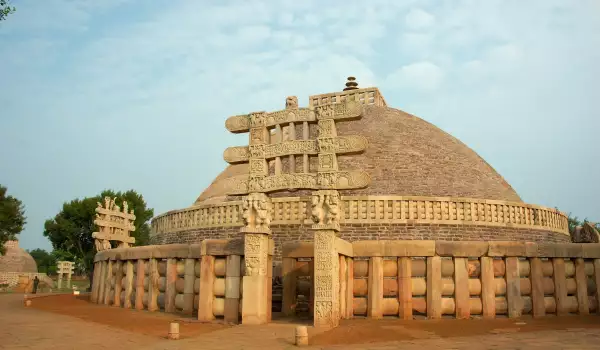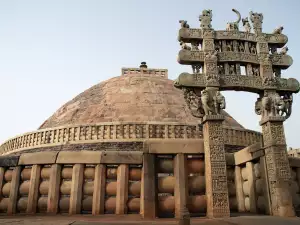Sanchi

Sanchi is one of the most important places of pilgrimage for Buddhists. Sanchi is a small Indian village, located in Raisen District in the Indian state Madhya Pradesh. Here you can see several ancient Buddhist monuments, dating from the third century BC to the middle Ages - 12th century. The most interesting among them is the huge Sanchi. Since 1989 local Indian temples are listed as an UNESCO World Heritage Site.
Located about 9 km southwest of Vidisha, the monuments of Sanchi stand on a hill about 90 meters high. Sanchi is not only unique in that it has managed to keep one of the best looking stupas today, but this that there can be traced the genesis, heyday and decline of Buddhist art and architecture over a period of about thirteen hundred years. All that can be seen in the Sanchi is a reflection of almost the entire period of Buddhism.
Although Sanchi had not been the focus of Buddhist life in those distant ages (there is almost no written evidence or historical documentation for this), the monastery complex here is amazingly beautiful and comprehensive.
It is assumed that initially the stupa Sanchi was built by Emperor Ashoka, who ruled the region Ujjayini. His wife Devi was the daughter of a merchant from nearby Vidisha. They had a son and daughter - Mahindra and Sanghamitra, who were born in Ujjayini and sent to Sri Lanka to preach Buddhism.

The magnificent stupa, originally built in the 3rd century BC, at that time was a hemispherical brick structure built over relics of Buddha. A little later in this building in Sanchi reached a higher ranking as a Buddhist shrine – that of chatra. In the 2nd century. BC, the stupa is dilapidated and again restored by Emperor Pusyamitra Sunga. Later, the stupa was expanded with stone slabs with a size almost two times more impressive than its original size.
Today the stupa is located in the monastery complex Sanchi and all around it are religious ceremonies in which many laymen surround its base design. The stupa has a stone fence and 4 portals called torana, as well as traditional Buddhist and Hindu architecture. It was built around the 1st century BC.
They are decorated with remarkable carvings, and in places with statues and figures of humans and elephants. These can now be seen on the western and northern gates. On some relief can be recognized themes reflecting scenes from battles and sieges of the city.
At Sanchi is a preserved group of monuments of Buddhist culture, built at a later stage - between 5 and 12 century. Among them is the № 17 Temple, built in the 5th century and is called "God's temple." The core of the temple is made of stone, with a cubic sanctuary for indoor deities, flat collars and a front door with four pillars.
The interesting architecture with its temple are representing the Buddhist temple and the building for prayer. In Sanchi, there are the temple № 40 and № 18, built in the 7th century from stone in place of the former wooden temples. At Sanchi is the famous column of the patron of Buddhism - the ruler Ashoka.











